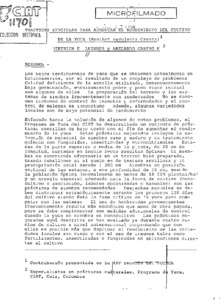Practicas sencillas para aumentar el rendimiento del cultivo de la yuca (Manihot esculenta Crantz)
The low cassava yields obtained in L.A. at present are the result of a complex of problems: 1) deficient quality of planting material, which results in low sprouting, poor rooting and little initial vigor; 2) inadequate land preparation and planting systems; 3) control systems for pests and diseases are unknown and weed control, untimely; 4) some local var. have a low yield potential. The CIAT Cassava Program has developed a set of simple low-cost practices aimed towards increasing cassava yields. These improved practices include the selection of healthy and mature planting material and its chemical treatment with fungicides, insecticides and micronutrients. The best cuttings are 20 cm long, from the upper or middle part of the plant and cut at a right angle. It is recommendable to carry out planting on well-prepared land, using ridges if the soil is of a clay texture and if annual rainfall exceeds 1200 mm. Recommended planting practices are: planting the cutting in a vertical position, at a depth of 10 cm, using an optimum density (normally not less than 10,000 plants/ha) and a spatial arrangement adequate for the form of cultivation used (monoculture or association, mechanized or manual labor). Manual weeding should be strategically distributed during the 1st 120 days after planting, this being the critical stage of weed competition with cassava. The use of preemergence herbicides is frequently more economical than manual labor but has to be complemented with additional control measures when cassava is planted in monoculture. These improved practices have been evaluated on an international basis for 4 crop cycles; with them it is possible to more than double the yields of local var. without irrigation and the use of fertilizer, insecticide and fungicide inputs. (AS-CIAT)

